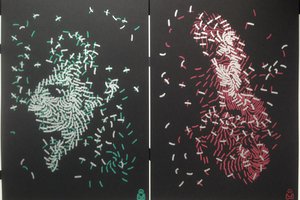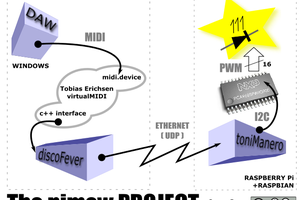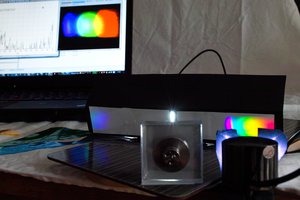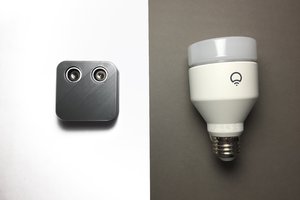The 1.0 version of the instrument was presented to the public several times. For the first time on July 14, 2019 at the “night of sience” at the University of Frankfurt, and in 2019 at the SKOP festival “Computer-Music V” in Frankfurt. Due to the corona pandemic, the other concerts with the instrument could only take place via the Internet, on March 29, 2020 and October 21, 2020. A composition by Phill Niblock, New York was realized with the instrument and came in December 2020 in New York, at Roulette, premiered. The development of the instrument began 3 1/2 years ago and at the beginning it was not foreseeable that it would develop in this way.
Some developments have been made since version 1.0. They include extensions on the software and hardware side.
The tuning systems play a decisive role in the programming / compositions. The differences between individual tones, as they appear acoustically, can be clearly perceived. Since they are related to the position values and the LEDs, the positions can be reproduced at any time and can be perceived visually / acoustically. The position values are summarized in large array lists and related to each other in terms of programming. In order to get into very small pitch differences, the position values for 106th root of 2 were determined. They make it possible to shape the given tone space to the limit of perception. This made it possible to bring the tuning systems together as a unit, to represent small and very small intervals. Individual tuning systems are optically indicated by the different colors of the LEDs, see picture. This is an essential requirement for playing the instrument via gesture control. A player perceives this through the colored LEDs, is stimulated by these optical impressions to determine - undefined position trips. He doesn't have to know anything about the musical-technical requirements for his playing.
Gesture control offers new possibilities for playing with the instrument. With conventional programming, the string divider can move exactly one position with a tenth of a millimeter. A difference in tones could already be perceived at 2 millimeters. This accuracy made the pure intervals appear in strong resonance, a deviation of 2 millimeters led to a significant weakening of this hearing impression. As a result, the pure intervals could be determined very well in connection with programming-technical processes.The software enables a fast and precise achievement of main intervals such as: Pure consonances, Pythagorean intervals, 106th-root-of-2 intervals, etc. When the player enters a range of values for one of these intervals, the software controls the motors to the exact position and a game action is triggered. Also, a player can independently steer to any position and trigger actions.
Since both parts of the string always emit a tone when playing with the pick, the small pitch differences could be clearly perceived. Especially when there was no vibrato in the composition. The play of overtones was also specifically programmed. The pick is placed very softly and the string is released from the damper at the right moment.
The camera-Teensy interface was programmed by Thomas Perizonius, who was also involved in the development of the pickups.
The new formula for calculating the travel path based on hand movements now makes it possible for the sliders to quickly cover the entire path with a quick movement of the hands or to move the slider by 1/10 mm with a slow movement of the hands. This enables the precise control of a target. The solution was an exponential equation. I tested different bases and exponents. A basis of 5.35 and an exponent of 6 was optimal. Since the entire length of the travel path from the position slider is 26265 individual steps, the exponential equation results in the smallest possible step of approx. 0.4 mm.
see programming image.
 peter wiessenthaner
peter wiessenthaner
 Christian Walther
Christian Walther
 Oscar Sanz Llopis
Oscar Sanz Llopis
 Friedrich Menges
Friedrich Menges
 Gary Peng
Gary Peng